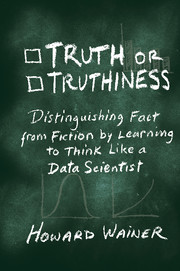Book contents
Section II - Communicating Like a Data Scientist
Published online by Cambridge University Press: 05 December 2015
Summary
Introduction
Princeton's polymath John Tukey (1915–2000) often declared that a graph is the best, and sometimes the only, way to find what you were not looking for. Tukey was giving voice to what all data scientists now accept as gospel – statistical graphs are powerful tools for the discovery of quantitative phenomena, for their communication, and even for the efficient storage of information.
Yet, despite their ubiquitousness in modern life, graphical display is a relatively modern invention. Its origins are not shrouded in history like the invention of the wheel or of fire. There was no reason for the invention of a method to visually display data until the use of data, as evidence, was an accepted part of scientific epistemology. Thus it isn't surprising that graphs only began to appear during the eighteenth-century Enlightenment after the writings of the British empiricists John Locke (1632–1704), George Berkeley (1685–1753), and David Hume (1711–76) popularized and justified empiricism as a way of knowing things.
Graphical display did not emerge from the preempirical murk in bits and pieces. Once the epistemological ground was prepared, its birth was more like Botticelli's Venus – arising fully adult. The year 1786 is the birthday of modern statistical graphics, devised by the Scottish iconoclast William Playfair (1759–1823) who invented what was an almost entirely new way to communicate quantitative phenomena. Playfair showed the rise and fall over time of imports and exports between nations with line charts; the extent of Turkey that lay in each of three continents with the first pie chart; and the characteristics of Scotland's trade in a single year with a bar chart. Thus in a single remarkable volume, an atlas that contained not a single map, he provided spectacular versions of three of the four most important graphical forms. His work was celebrated and has subsequently been seized upon by data scientists as a crucial tool to communicate empirical findings to one another and, indeed, even to oneself.
In this section we celebrate graphical display as a tool to communicate quantitative evidence by telling four stories. In Chapter 8 we set the stage with a discussion of the empathetic mind-set required to design effective communications of any sort, although there is a modest tilting toward visual communications.
- Type
- Chapter
- Information
- Truth or TruthinessDistinguishing Fact from Fiction by Learning to Think Like a Data Scientist, pp. 79 - 81Publisher: Cambridge University PressPrint publication year: 2015



